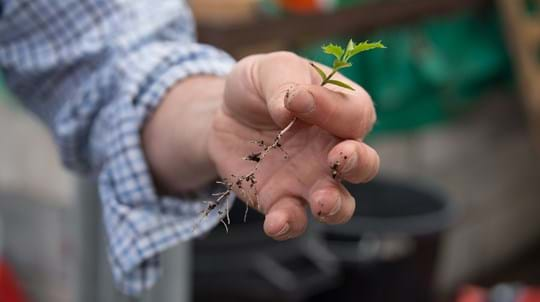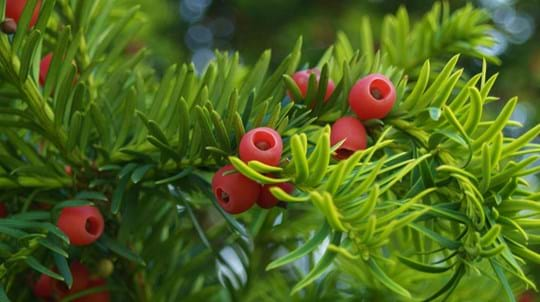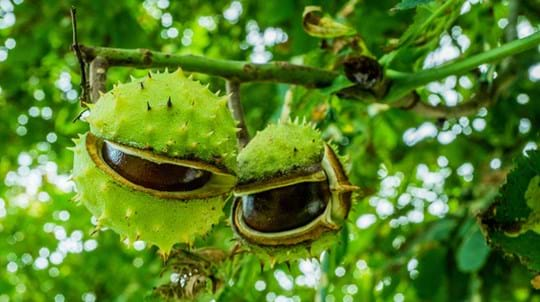Trees for birds
Looking for ways to attract more wild visitors to your garden? Buy fruiting trees birds (and you) will love.
Visit our shop
Content manager
Trees have a bit of a problem on their hands. If their seeds are to stand a good chance of survival, they need to spread them to new locations out of the parent tree's shadow. But how do they achieve this without moving parts?
The simplest way to spread your seeds is to allow them to drop from a height. Hard or rounded seeds may bounce or roll some distance from where they first hit the earth. Those in a tough shell or case, such as the conkers of horse chestnut, may also split open and scatter their contents
One of the more unusual ways to spread seeds is to expel them by force. The seeds of gorse are contained within pods which slowly dry out in warm, sunny weather. Once enough moisture has evaporated the pod splits open, flinging the seeds inside some distance.
Listen carefully to gorse bushes in summer and you'll hear the telltale popping sound of this clever method in action.
Some plants are able to plant their own seeds! Ivy-leaved toadflax grows in the crevices of walls. Once its long flower stalks have been pollinated, the seed heads bend towards the wall's surface, shedding seeds into new cracks. This is known as blastochory.
Trees may not be able to move, but some are good at procuring the services of animals that can.
Fruit-bearing trees such as rowan offer birds a tasty reward for carrying off their seeds. Encased in nutritious, brightly coloured pulp, some may be plucked from the tree and dropped en route to a new location. Other berries are eaten, and an indigestible coating protects the seed inside as it travels through the digestive system. Once the seed exits it may be far from the parent tree, and deposited in a handy dollop of fertiliser too.
Oaks go a step further. They take advantage of the storing behaviour of jays and squirrels to get their seeds both transported and ready planted. These animals put aside food to see them through the winter, often burying acorns in caches around their territory. While their memories are good, some acorns are inevitably forgotten. Those that escape a winter feast may germinate to sprout new trees.
Some plants don't offer their animal helpers a reward, but instead hitch a ride on fur or feathers using hooks and barbs on their seeds' surface.
Looking for ways to attract more wild visitors to your garden? Buy fruiting trees birds (and you) will love.
Visit our shopTrees have developed a number of ways to use the wind to their advantage.
Some, such as hazel, release their pollen into the air from catkins, trusting the tiny grains to encounter female flowers in their path. This way, there's no need to invest precious energy reserves producing nectar to tempt in pollinating insects. But there's a downside - this risky strategy leaves a lot to chance. The solution? To produce a lot of pollen at once, and to do so before leaves emerge each spring which might get in the way.
Birches also use the wind for pollination, as well as to distribute their seeds. They produce large numbers of tiny, lightweight winged seeds called samaras which float and glide on air currents. Willows instead release fluffy seeds which use a parachute effect to ride the breeze.
Ash, field maple and hornbeam seeds generate their own lift with their specially designed wings. These 'helicopter seeds' spin as they fall, creating a type of flight known as autorotation.
Damp-loving trees such as alder and willows often grow overhanging waterways. What better way to give your seeds a good start in life than to allow streams or rivers to sweep them to the ideal growing spots? This method has its challenges however. Seeds must stay afloat if they're to get anywhere, and they must be protected to prevent their food supply from rotting.
Alder seeds contain pockets of air and two cork appendages to keep them buoyant. Studies have found them capable of floating in water for a whole year without being damaged.
The fluffy white seeds of weeping willow may even benefit from dispersal by water. They're light enough to float on both air currents and water, but if kept cool and moist they stay fresh for longer. In fact, weeping willow seeds spread by water can last for up to a month, whereas normally their viability begins to drop after 10 days.

Plant trees
Growing a tree from a seed needn't be tricky. Find out how to do just that with our simple instructions.

Blog
Charlotte Varela • 30 Sep 2023

Blog
Rachel Hoskins • 30 Aug 2019